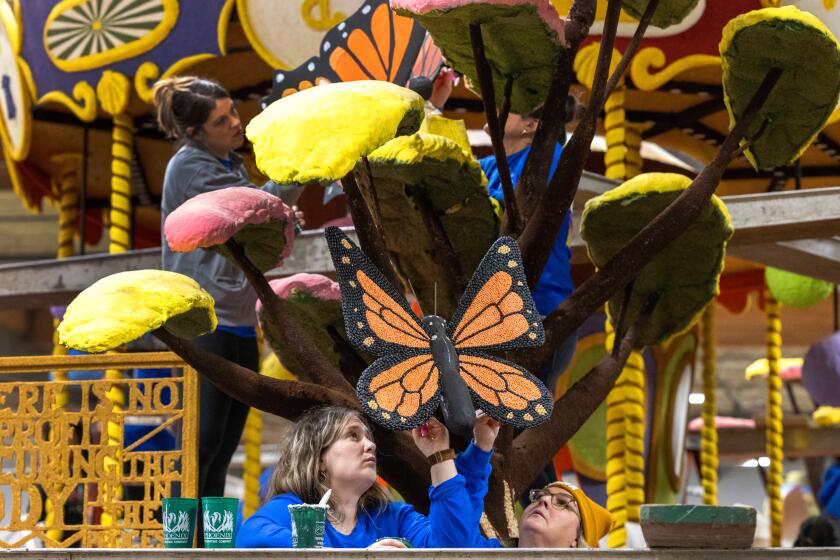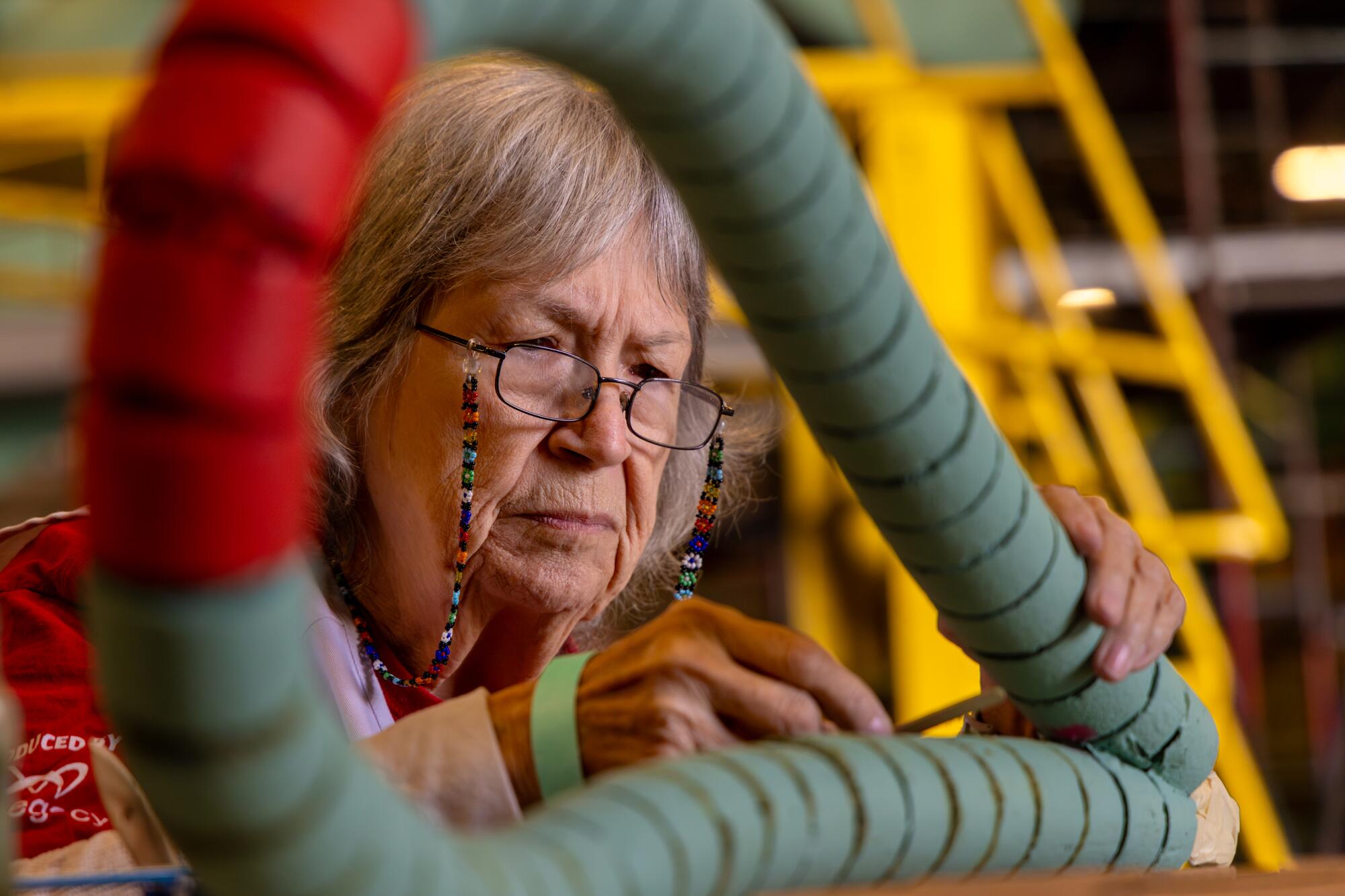
- Share via
Just as the trees have begun to lose their leaves in Granite City, Ill., and fall begins to take on the early shades of winter, Victoria Boyd feels the pull of California.
Just as the Santa suit goes off to the cleaners, boots polished and stored in the closet of his home in neighboring Madison, David Becherer feels the pull of California.
But the California that the two longtime friends are drawn to is not a land of palm trees, blue skies and sunny waves on the beach.
Instead it’s a land of glue and make-believe in a drafty warehouse next to the 210 Freeway in Irwindale, where pink flamingos are as tall as blossoming yuccas, butterflies have the wingspan of condors and lotus flowers are the size of hubcaps.

If they see the sun, it will be during a break. The beach is not on their itinerary, and if they’re looking for a moment of rest, it will be when they get back home.
They have a job to do and a deadline to meet. Dec. 31 waits for no one, especially for volunteers like Boyd and Becherer who put in the 12-hour days and double shifts to complete the work on floats for the Rose Parade.
Volunteers help decorate the 2024 Rose Parade floats to prepare them for their New Year’s Day debut.
They have made this annual pilgrimage from the frozen Midwest for more than three decades. As a former part-time florist, Becherer used to watch the parade on television, intrigued by the elaborate arrangements and the artistry piled on these rolling platforms, and when he learned he could be part of the spectacle, he jumped. Boyd soon followed.
Her streak has been unbroken since 1987; he took a little time off to care for his family. Their devotion to this annual celebration of camp is unwavering, their commitment close to an obsession.
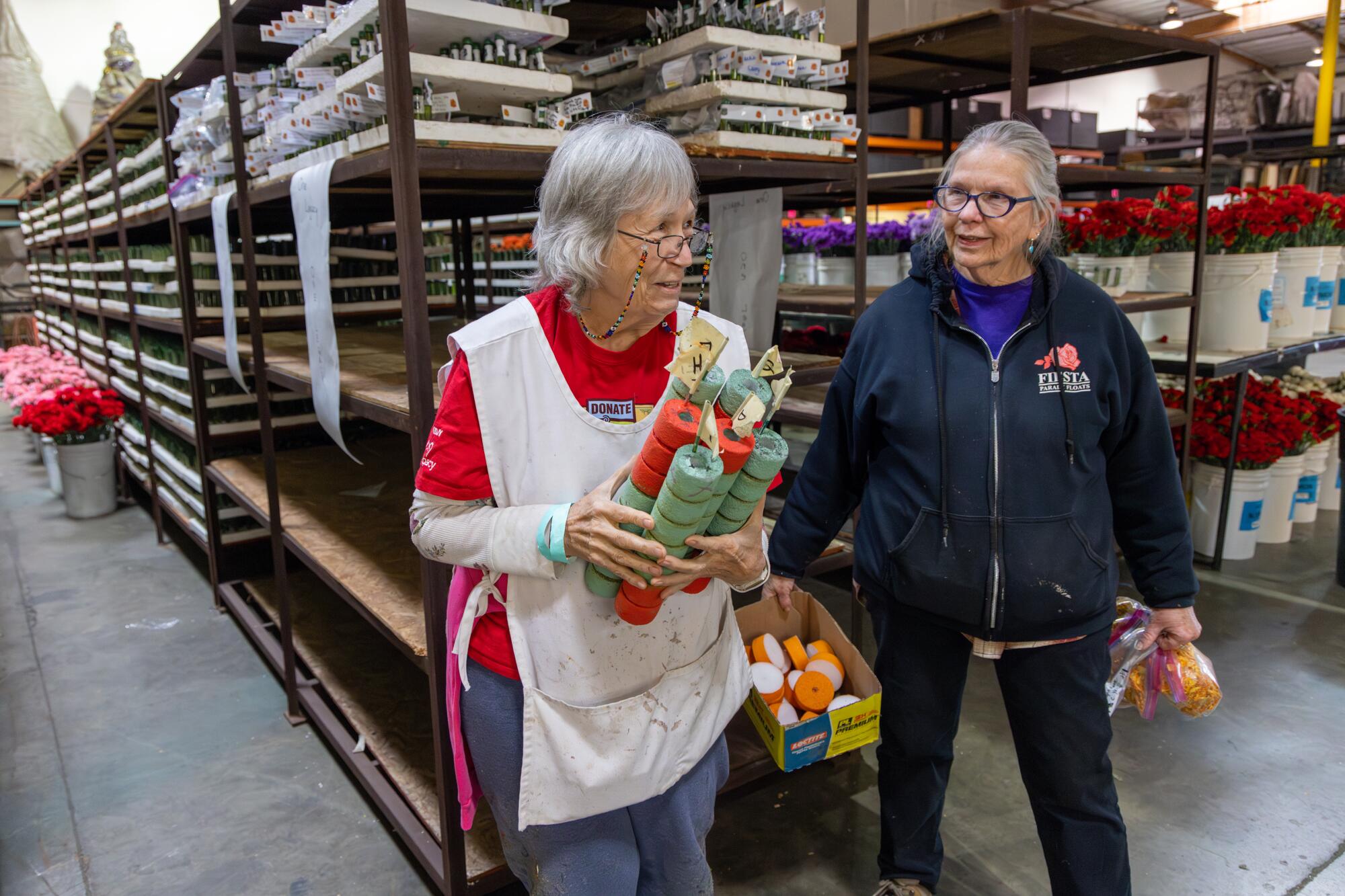
“Unless I’m too tired and full of glue, I feel that I didn’t get my money’s worth,” said Boyd, 79, who sees no end to this tradition.
“How long am I going to be doing this?” she asks. “Well, as long as I can. I don’t think I can stay home. I don’t think I cannot be here.”
On Thursday afternoon, Boyd and Becherer, both former teachers, sit at a small table gluing minced safflower petals onto a string of Styrofoam beads as large as softballs that will soon be placed on the neck of a Hopi butterfly dancer rising from the middle of the float.
They belong to a unique confederacy of nearly 1,000 volunteers who arrive each day at Fiesta Parade Floats, the last week of the year, to begin and end the meticulous and tedious task of chopping flowers, carting supplies, climbing scaffolding, spreading glue, and applying flowers, seeds, bark and spices to an unwieldy contraption of steel, plywood, burlap and polyurethane.
Let others here and across the country take in the polish and perfection of the Rose Parade for a few hours on New Year’s Day. These workers prefer the weeklong company of like-minded devotees dedicated to bringing to life scenes spun from the imagination, from nature and storybooks, from fairy tales and myth.
“We’re part of a cult that comes out here every year, and Dave and I are charter members,” said Boyd, who counts friends from Maine, Louisiana and Michigan. More than a tenth of the workforce arrives from out of state and out of country, some from as far as New Zealand and England, according to a spokesperson with Fiesta, and all on their own dime.
Boyd estimates that she will spend about $2,500 this year — flights, motel, car rental — for the opportunity to work on these “magnificent, awesome” works of art and “to be out of the cold Midwest for a week.”
“That’s a bonus too,” she said.
Barbara Hill may not be a member of any decorating cult, but her dedication is no less intense. For three days last week, she climbed aboard the Torrance Rose Float Assn.’s yellow school bus at 7:45 a.m. for the hourlong ride to Irwindale.
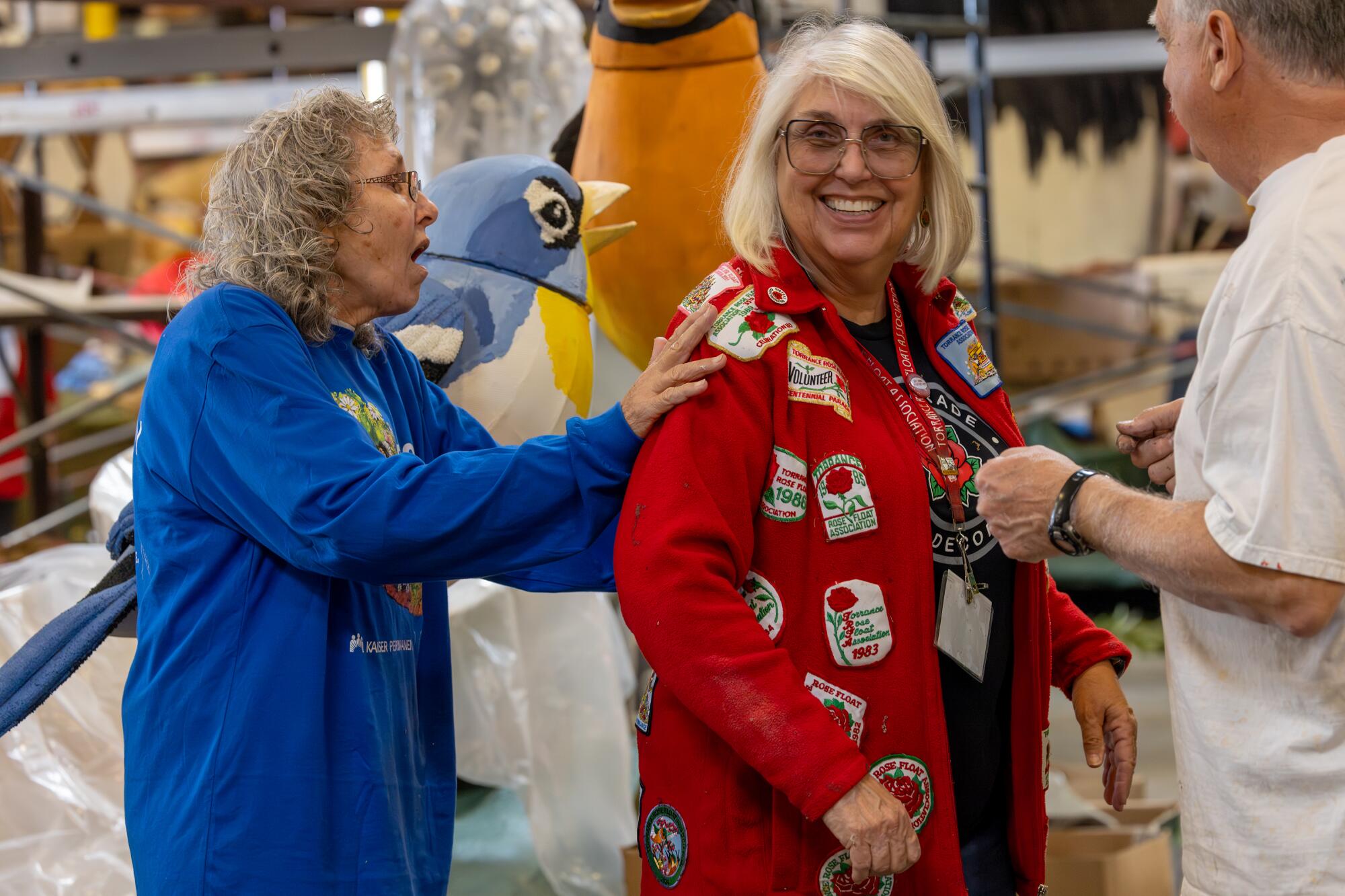
Hill, 72, a retired purchaser for Northrop Grumman (think F-18s and B-2s), decorated her first float in 1980, and today she’s focused on flying hummingbirds, having woven together grapevine and moss to create a nest as large as a hot tub.
Though every detail of every float is scripted in advance — specifications listing material, texture and application — the volunteers are given leeway to make sure the execution is effective, the illusion believable. If it means modifying ingredients — and permission is granted — then so be it.
Though this creativity appeals to Hill, the heart of the experience is the friendships, she said, that form over these few days.
“That is the finest thing,” she said. “They assign you to someone whom you’ve never met, and you find a way to work together to get this float done. And in the end, we smile and say, ‘See you again next year.’ ”
And when they do, they will reminisce over their successes and failures. Like the time they created the most realistic mane for a lion — cypress branches coated with paprika — or the time their shaggy dog made of pampas grass caught fire just minutes before the start of the parade.
Or when they won the Sweepstakes Trophy — the parade’s top prize based on floral design, presentation and entertainment — as Boyd and Becherer’s float did last January for the sinuous red and yellow Chinese dragon and lanterns they crafted.

They’re hoping for a repeat and are feeling confident as they check out the competition.
“We’re not so competitive, as we are territorial,” said Boyd, who looks at one float that seems far behind schedule. “I’m not sure how they’ll get it done in time.”
But with only five floats in the Fiesta warehouse, the statistical sample is small. Thirty-six others — under constructed at sites elsewhere — will participate in the parade, each interpreting this year’s theme: “Celebrating a World of Music: The Universal Language.”
At the moment, however, the language is more discordant: a steady din of voices amid sporadic sounds of vacuum cleaners, welding torches, hair dryers and blenders. The air smells of flowers tinged with the essence of glue, of which there are the three varieties — white, sticky and rubber. Boyd is well versed in each.
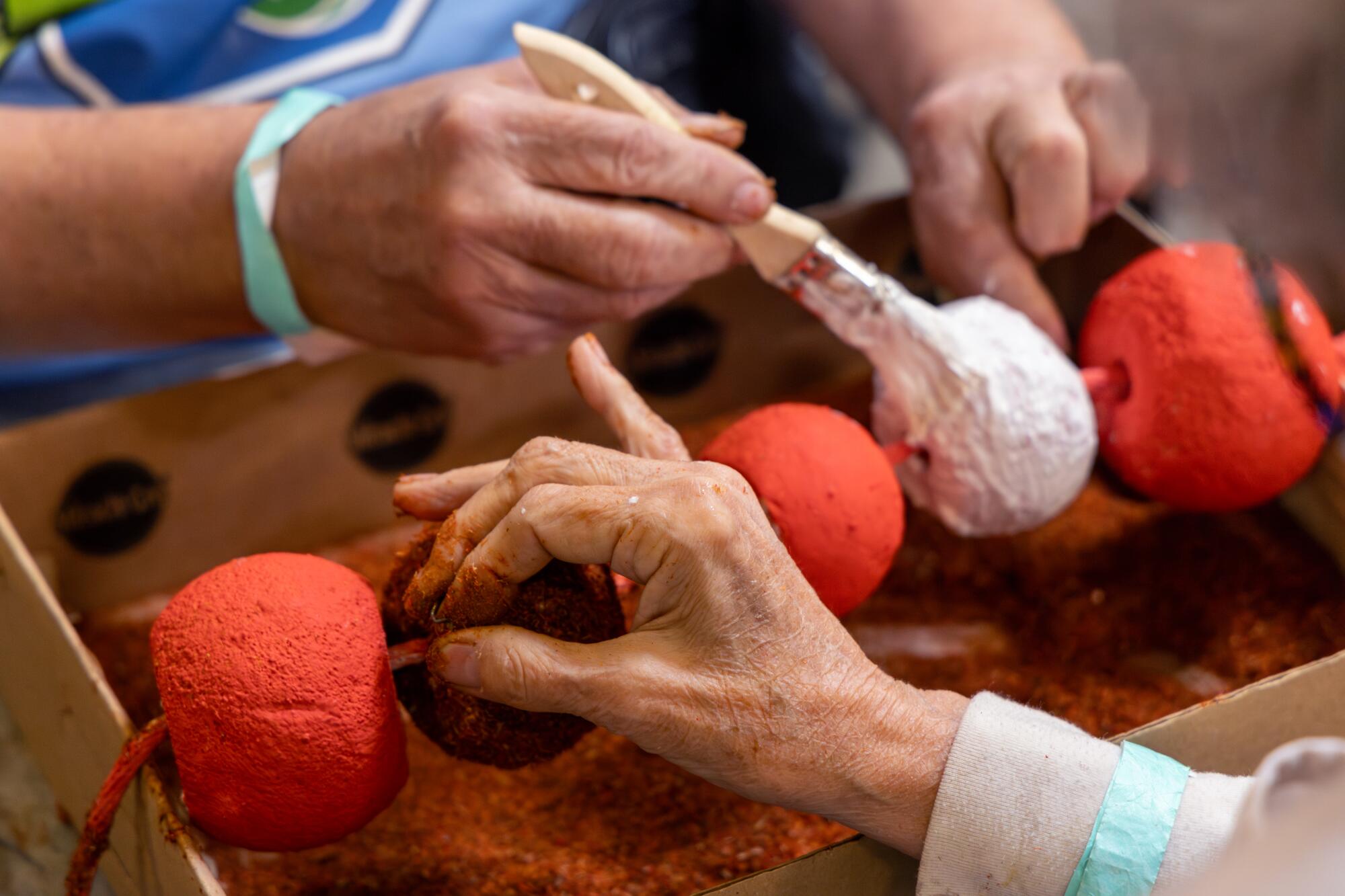
Her fingertips are stained orange from crushed flowers stuck to the skin. She tries to wash it off, but the effort is futile. “After Day 3, my phone doesn’t recognize me because I no longer have fingerprints,” she said. “That is a badge of honor.”
As she and Becherer finish their choker for the Hopi butterfly dancer, they get ready to start on a pendant and earrings. Boyd likes the detail work, though she would prefer to be handling whole flowers, not the shredded ones. She calls it “petaling,” the application of individual petals from carnations, irises, gladiolas and the like.
Amid a season of striking workers and war protesters, agencies responsible for security during the Rose Parade have been actively preparing for potential demonstrations ahead of the New Year’s Day event.
“It’s more intricate,” she said, and under-appreciated because float designers “just haven’t seen a good petal job.”
They know their work is ephemeral, that their efforts will age and wither and dry. “I try not to focus on that,” Boyd said. “It’s sad to think it doesn’t last.”
But Becherer, the seasonal Santa, sees it differently. “It’s just like Christmas,” he said. “You enjoyed it when it was here, then it’s over and you get to start all over again in a year.”
When their work is done, they might pitch in on other floats, but come Sunday, all volunteers at Fiesta disperse.
Hill will head back to home in the South Bay, eager for a hot bath and a soft bed. She will wake up at 8 on New Year’s Day to watch the parade, making sure her float goes by without mishap, and then go back to sleep and wait 51 weeks.
On Monday, Boyd and Becherer will head to the parade route to admire their handiwork. Like newcomers to the experience, they will sit in their chairs, possibly the bleachers, and exclaim when the Hopi butterfly dancer draws near.
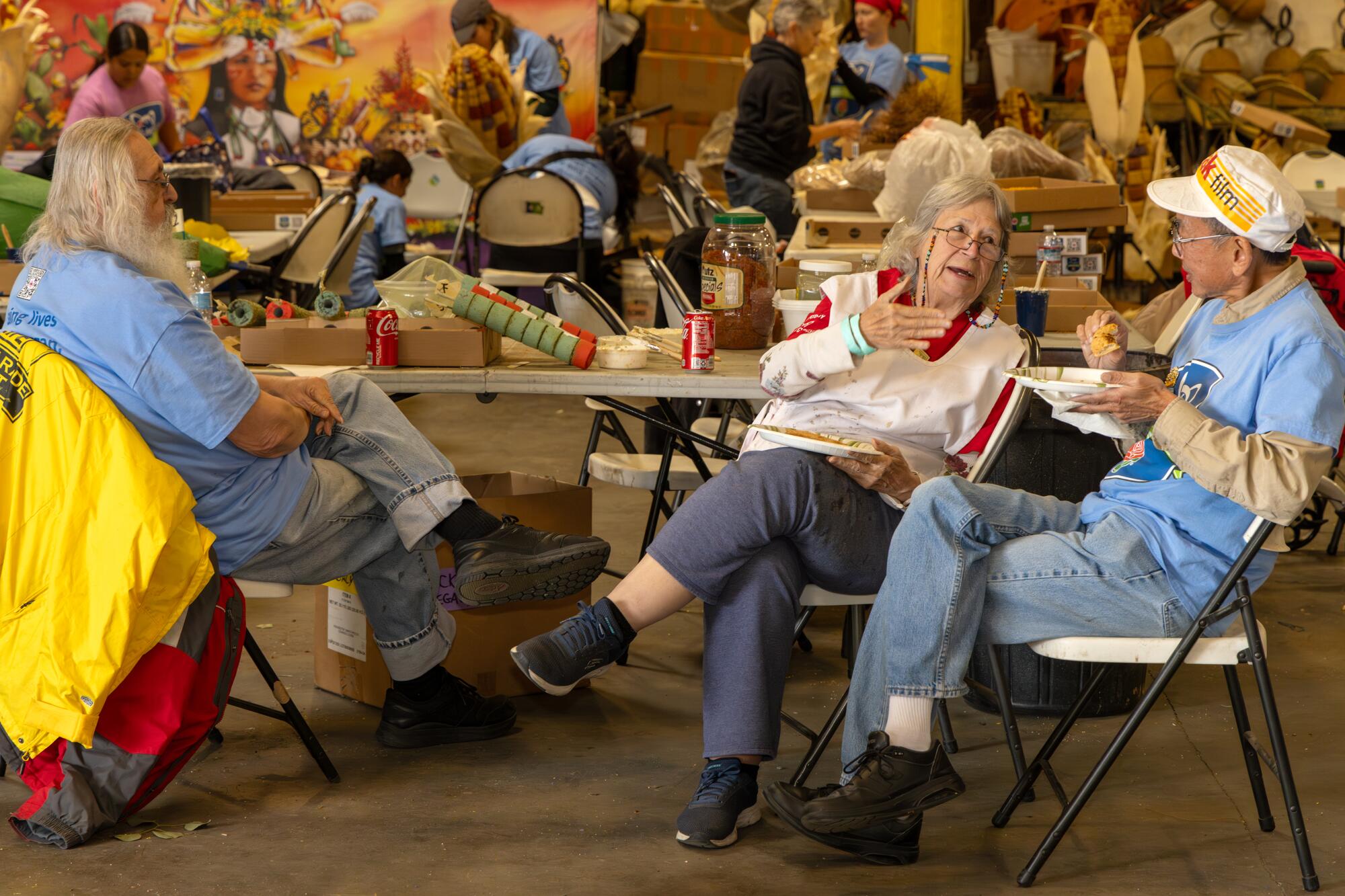
“When we see our float,” said Becherer, recalling the feeling over the years, “we swell with pride. We let everyone around us know that we did that.”
For Boyd, nothing comes close to the Rose Parade. She has seen similar processions elsewhere — Louisiana, Oregon, New York City — but is spoiled by the size and scope and scale of what comes down Colorado Boulevard each year.
“It’s beautiful,” Becherer agrees. “It brings a lot of people together, not only those watching from the street but everyone who worked on the floats. It’s a joy to be around people like that. There is so much division in this world today; no one can agree on anything. Now’s the time for people to come together.”
More to Read
Sign up for Essential California
The most important California stories and recommendations in your inbox every morning.
You may occasionally receive promotional content from the Los Angeles Times.
